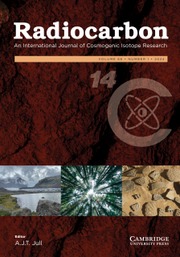Crossref Citations
This article has been cited by the following publications. This list is generated based on data provided by
Crossref.
Pearson, Gordon W.
and
Stuiver, Minze
1993.
High-Precision Bidecadal Calibration of the Radiocarbon Time Scale, 500–2500 BC.
Radiocarbon,
Vol. 35,
Issue. 1,
p.
25.
Stuiver, Minze
and
Becker, Bernd
1993.
High-Precision Decadal Calibration of the Radiocarbon Time Scale, AD 1950–6000 BC.
Radiocarbon,
Vol. 35,
Issue. 1,
p.
35.
Stuiver, Minze
and
Braziunas, Thomas F.
1993.
Modeling Atmospheric 14C Influences and 14C Ages of Marine Samples to 10,000 BC.
Radiocarbon,
Vol. 35,
Issue. 1,
p.
137.
Vogel, J. C.
and
van der Plicht, Johannes
1993.
Calibration Curve for Short-Lived Samples, 1900–3900 BC.
Radiocarbon,
Vol. 35,
Issue. 1,
p.
87.
Stuiver, Minze
and
Pearson, Gordon W.
1993.
High-Precision Bidecadal Calibration of the Radiocarbon Time Scale, AD 1950–500 BC and 2500–6000 BC.
Radiocarbon,
Vol. 35,
Issue. 1,
p.
1.
Bowman, Sheridan
1994.
Using radiocarbon: an update.
Antiquity,
Vol. 68,
Issue. 261,
p.
838.
McFadgen, B.G.
Knox, F. B.
and
Cole, T. R. L.
1994.
Radiocarbon Calibration Curve Variations and Their Implications for the Interpretation of New Zealand Prehistory.
Radiocarbon,
Vol. 36,
Issue. 2,
p.
221.
Kromer, Bernd
1994.
Bernd Becker, 1940–1994.
Radiocarbon,
Vol. 36,
Issue. 1,
p.
v.
McFadgen, B.G.
1994.
Archaeology and holocene sand dune stratigraphy on Chatham Island.
Journal of the Royal Society of New Zealand,
Vol. 24,
Issue. 1,
p.
17.
Taylor, R. E.
1995.
Radiocarbon dating: The continuing revolution.
Evolutionary Anthropology: Issues, News, and Reviews,
Vol. 4,
Issue. 5,
p.
169.
Damon, Paul E.
1995.
Note Concerning “Intercomparison of High-Precision 14C Measurements at the University of Arizona and the Queen's University of Belfast Radiocarbon Laboratories” by Kalin et al. (1995) and the Regional Effect.
Radiocarbon,
Vol. 37,
Issue. 3,
p.
955.
Holley, Mark W.
and
Ralston, Ian B. M.
1995.
Radiocarbon dates for two crannogs on the Isle of Mull, Strathclyde Region, Scotland.
Antiquity,
Vol. 69,
Issue. 264,
p.
595.
Michczyński, Adam
Krzanowski, Andrzej
Pazdur, Mieczysław F.
and
Ziołkowski, Mariusz S.
1995.
A Computer-Based Database for Radiocarbon Dates of Central Andean Archaeology.
Radiocarbon,
Vol. 37,
Issue. 2,
p.
337.
Southon, John R.
Oakland Rodman, Amy
and
True, Delbert
1995.
A Comparison of Marine and Terrestrial Radiocarbon Ages from Northern Chile.
Radiocarbon,
Vol. 37,
Issue. 2,
p.
389.
Sparks, R. J.
Melhuish, W. H.
McKee, J.W. A.
Ogden, John
Palmer, J. G.
and
Molloy, B. P. J.
1995.
14C Calibration in the Southern Hemisphere and the Date of the Last Taupo Eruption: Evidence from Tree-Ring Sequences.
Radiocarbon,
Vol. 37,
Issue. 2,
p.
155.
McCormac, F. G.
Baillie, M. G. L.
Pilcher, J. R.
and
Kalin, R. M.
1995.
Location-Dependent Differences in the 14C Content of Wood.
Radiocarbon,
Vol. 37,
Issue. 2,
p.
395.
Higham, T. F. G.
and
Hogg, A. G.
1995.
Radiocarbon Dating of Prehistoric Shell from New Zealand and Calculation of the δr Value Using Fish Otoliths.
Radiocarbon,
Vol. 37,
Issue. 2,
p.
409.
Simons, Elwyn L.
Burney, David A.
Chatrath, Prithijit S.
Godfrey, Laurie R.
Jungers, William L.
and
Rakotosamimanana, Berthe
1995.
AMS 14C Dates for Extinct Lemurs from Caves in the Ankarana Massif, Northern Madagascar.
Quaternary Research,
Vol. 43,
Issue. 2,
p.
249.
Braziunas, Thomas F.
Fung, Inez Y.
and
Stuiver, Minze
1995.
The preindustrial atmospheric14CO2 latitudinal gradient as related to exchanges among atmospheric, oceanic, and terrestrial reservoirs.
Global Biogeochemical Cycles,
Vol. 9,
Issue. 4,
p.
565.
Bartolomei, Paolo
Cecchini, Stefano
Cini, Stefano
Galli, Menotti
Gaimpieri, Roberto
Mongardi, Cinzia
Nanni, Teresa
and
Salomoni, Agostino
1995.
Solar Flare Particle Effects and Seasonal Radiocarbon Variations in Tree Rings of the Northern and Southern Hemispheres.
Radiocarbon,
Vol. 37,
Issue. 2,
p.
593.

